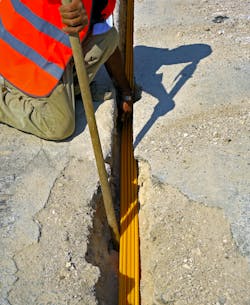As noted by TelcoTitans' Deutche Telekomwatch site, in a June 7 piece penned by Anne Morris largely concerning how the European fiber telecom giant's rivals maintain sharp criticisms of the company's FTTP overbuild tactics, Morris noted that Bloomberg reporting from May highlighted, on a larger scale, certain fundamental problems with the actual techniques that telcos use to lay fiber.
As reckoned by TelcoTitans' Morris:
"According to the report, modern fibre deployment techniques such as micro-trenching are in fact adding to a problem that appears to be peculiar to Germany: it is becoming increasingly difficult to identify the estimated 5.7 million kilometres of underground cables and pipes for gas, power, sewage, telecommunications, and water that lie beneath the nation’s streets.
As a consequence, German policymakers and planners are warning that the recent catastrophe that forced Lufthansa, Germany’s largest airline carrier, to ground hundreds of flights may not be the last (Deutsche Telekomwatch, #122). It transpired that “third-party” engineers, hired by DT, accidentally cut through four fibre-optic cables, using concrete drills, when carrying out 'construction work' on a Deutsche Bahn rail line in Frankfurt."
As further cited by Morris, according to a February 2019 report by Deutsche Gesetzliche Unfallversicherung (German Social Accident Insurance/DGUV), there are about 100,000 accidental cable cuts per year in Germany. In response to the problem, Deutsche Telekomwatch's Morris notes that "Telekom Deutschland has been adopting processes, systems, and tools that can save costs and time in next-generation broadband delivery, including micro-trenching and machine learning-aided fibre route planning."
Notwithstanding, Morris' piece goes on:
However, Susanne Hake, Head of Energy and Broadband at construction lobby group Hauptverband der Deutschen Bauindustrie, told Bloomberg that shallow placement techniques mean that "some fibre-optic cables are located just a hand’s width under the asphalt."
"A builder would have to excavate [them] with an 'archaeological brush,'" she added.
Machine learning for fiber infrastructure route planning
As noted in this video by Fraunhofer, Europe's largest application-oriented research organization, for applications such as autonomous driving or parcel delivery by drone to be a reality in Germany, the prerequisite is secure, stable and fast data transmission, which can only be achieved with an area-wide fiber optic network.
However, in today's crowded public infrastructures, to find just the right place for cable ducts is often a difficult task that takes tremendous effort. The following video relates how Prof. Alexander Reiterer, Dominik Störk and Dr. Katharina Wäschle from the Fraunhofer Institute for Physical Measurement Techniques IPM have developed a novel process chain based on machine learning that solves this issue. For this, the researchers received the Joseph von Fraunhofer Prize.
"We have developed a unique process chain: It can evaluate two- and three-dimensional data fully automatically, recognize the corresponding application-specific objects and integrate them into digital planning maps," explained Prof. Reiterer, who is responsible for the development at Fraunhofer IPM.
For Deutsche Telekom – the first company to rely on the new process chain from Fraunhofer IPM – Fraunhofer said that this means that planning the fiber-optic expansion for a small town will only take a few days instead of several weeks.
"First tests show: With the data basis from our tool, Deutsche Telekom can carry out the entire planning process up to 70 times faster – and that fully automatically," added Dominik Störk, computer scientist at Fraunhofer IPM.
For more news, projects, and profiles in the ICT cabling and connectivity sphere, subscribe to the CI&M newsletter and follow us on LinkedIn, Twitter, and Facebook.

